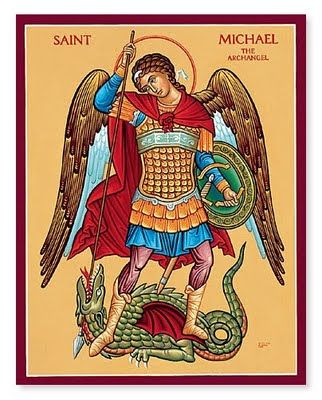During the Middle Ages, Michaelmas was celebrated as a Holy Day of Obligation, but this tradition was abolished in the 18th century.[8] In medieval England, Michaelmas marked the ending and beginning of the husbandman's year, George C. Homans observes: "at that time harvest was over, and the bailiff or reeve of the manor would be making out the accounts for the year."[9]
Because it falls near the equinox, this holy day is associated in the northern hemisphere with the beginning of autumn and the shortening of days. It was also one of the English, Welsh, and Irish quarter days, when accounts had to be settled. On manors, it was the day when a reeve was elected from the peasants.[10] Michaelmas hiring fairs were held at the end of September or beginning of October.[11] The day was also considered a "gale day" in Ireland when rent would be due, as well as a day for the issuing or settling of contracts or other legal transactions.[12]
WELKE DATUM?

During the Middle Ages, Michaelmas was celebrated as a Holy Day of Obligation, but this tradition was abolished in the 18th century.[8] In medieval England, Michaelmas marked the ending and beginning of the husbandman's year, George C. Homans observes: "at that time harvest was over, and the bailiff or reeve of the manor would be making out the accounts for the year."[9]
Because it falls near the equinox, this holy day is associated in the northern hemisphere with the beginning of autumn and the shortening of days. It was also one of the English, Welsh, and Irish quarter days, when accounts had to be settled. On manors, it was the day when a reeve was elected from the peasants.[10] Michaelmas hiring fairs were held at the end of September or beginning of October.[11] The day was also considered a "gale day" in Ireland when rent would be due, as well as a day for the issuing or settling of contracts or other legal transactions.[12]
WELKE DATUM?
During the Middle Ages, Michaelmas was celebrated as a Holy Day of Obligation, but this tradition was abolished in the 18th century.[8] In medieval England, Michaelmas marked the ending and beginning of the husbandman's year, George C. Homans observes: "at that time harvest was over, and the bailiff or reeve of the manor would be making out the accounts for the year."[9]
Because it falls near the equinox, this holy day is associated in the northern hemisphere with the beginning of autumn and the shortening of days. It was also one of the English, Welsh, and Irish quarter days, when accounts had to be settled. On manors, it was the day when a reeve was elected from the peasants.[10] Michaelmas hiring fairs were held at the end of September or beginning of October.[11] The day was also considered a "gale day" in Ireland when rent would be due, as well as a day for the issuing or settling of contracts or other legal transactions.[12]
WELKE DATUM?

Michaelmas - Wikipedia
ing of "Michael's Mass", in the same style as Christmas (Christ's Mass) and Candlemas (Candle Mass, the Mass where traditionally the candles to be used throughout the year would be blessed).[7] <span>During the Middle Ages, Michaelmas was celebrated as a Holy Day of Obligation, but this tradition was abolished in the 18th century.[8] In medieval England, Michaelmas marked the ending and beginning of the husbandman's year, George C. Homans observes: "at that time harvest was over, and the bailiff or reeve of the manor would be making out the accounts for the year."[9] Because it falls near the equinox, this holy day is associated in the northern hemisphere with the beginning of autumn and the shortening of days. It was also one of the English, Welsh, and Irish quarter days, when accounts had to be settled. On manors, it was the day when a reeve was elected from the peasants.[10] Michaelmas hiring fairs were held at the end of September or beginning of October.[11] The day was also considered a "gale day" in Ireland when rent would be due, as well as a day for the issuing or settling of contracts or other legal transactions.[12] Celebration[edit] On the Isle of Skye, Scotland, a procession was held.[8] One of the few flowers left around at this time of year is the Michaelmas daisy (also known as asters). Hence
Summary
| status | not learned | measured difficulty | 37% [default] | last interval [days] | |||
|---|---|---|---|---|---|---|---|
| repetition number in this series | 0 | memorised on | scheduled repetition | ||||
| scheduled repetition interval | last repetition or drill |